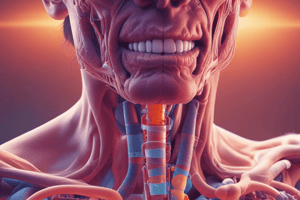Podcast
Questions and Answers
What does a small axillary scar typically indicate in a chest inspection?
What does a small axillary scar typically indicate in a chest inspection?
- Scar tissue from a healing wound
- Potential chest tube insertion (correct)
- Evidence of an axillary lymph node procedure
- Previous surgical intervention unrelated to lung issues
During a chest inspection, where should the inspector look for scars?
During a chest inspection, where should the inspector look for scars?
- At both axillae and the chest region (correct)
- Only around the heart area
- From the neck down to the abdomen
- Only on the back and side areas
Which finding is NOT typically associated with an axillary scar during inspection?
Which finding is NOT typically associated with an axillary scar during inspection?
- Evidence of a vascular access point (correct)
- Signs of infection
- Presence of subcutaneous tissue damage
- Indication of prior chest tube insertion
What is the significance of observing scars in the chest area during medical inspection?
What is the significance of observing scars in the chest area during medical inspection?
In what scenario would a small axillary scar most likely appear?
In what scenario would a small axillary scar most likely appear?
Which chest deformity is characterized by an increased antero-posterior diameter of the chest?
Which chest deformity is characterized by an increased antero-posterior diameter of the chest?
What does Pectus Carinatum refer to in terms of chest deformity?
What does Pectus Carinatum refer to in terms of chest deformity?
Which deformity is also known as funnel chest?
Which deformity is also known as funnel chest?
Which of the following conditions involves protrusion of the sternum?
Which of the following conditions involves protrusion of the sternum?
Which chest deformity is not categorized under the common types mentioned?
Which chest deformity is not categorized under the common types mentioned?
Flashcards
Axillary Scar
Axillary Scar
A small scar in the armpit area.
Chest Tube Insertion
Chest Tube Insertion
The placement of a tube in the chest cavity for drainage.
Inspection
Inspection
The act of closely examining something, such as the chest.
Scars
Scars
Signup and view all the flashcards
Axilla
Axilla
Signup and view all the flashcards
Pectus Carinatum
Pectus Carinatum
Signup and view all the flashcards
Pectus Excavatum
Pectus Excavatum
Signup and view all the flashcards
Barrel Chest
Barrel Chest
Signup and view all the flashcards
Study Notes
Examination Medicine - Respiratory System
-
Examination Steps: How to do examinations step-by-step, how to do maneuvers, and how to pass clinic exams.
-
Respiratory System Chapter: Covers various conditions related to the respiratory system.
Possible Short Cases
- COPD & Asthma
- Pleural Effusion
- Pneumonia
- Bronchiectasis
- Pneumothorax
- Interstitial Lung Disease (ILD)
Chest Examination From the Back (Setting Position)
- Introduction: Introduce yourself, stand on the patient's right and get permission for examination and exposure.
- Inspection: Look for scars (small axillary scar = chest tube insertion, large axillary scar = lobectomy or pneumonectomy).
Chest Movement
- Bilateral Decrease: Asthma, COPD, Bronchiectesis, Interstitial Lung Disease (ILD), Broncho-Pneumonia.
- Unilateral Decrease: Pleural Effusion (Lower Zone), Pneumothorax (Upper Zone), Lung Collapse, Lobar-Pneumonia, Pneumonectomy or Lobectomy.
Other Important Points
- Chest Deformity: Check for scoliosis, kyphosis, kypho-scoliosis from the back.
- Chest Deformity (Front): Check for Pectus Carinatum (Pigeon Chest), Pectus Excavatum (Funnel Chest), Barrel Chest in COPD.
Palpation
- Chest Expansion: Palpate three areas (1, 2, 3) on the back, asking the patient to breathe in and out.
- Tactile Vocal Fremitus (TVF): Use your hands to feel for vibration when the patient says specific words.
Percussion
- Listen for: Resonant, Hyper-Resonant (Tympanic), Dull, Stony Dull sounds while tapping different parts of the chest.
Auscultation
- Air Entry: Check if air entry is equal on both sides.
- Types of Breathing: Normal, Broncho-vesicular, Bronchial. Identify differences in breathing sounds (inspiration vs expiration).
- Added Sounds: Listen for Rhonchi (musical sounds), and Crepitation/Crackles (non-musical sounds).
- Vocal Resonance: Assessment similar to tactile vocal fremitus, but using a stethoscope.
Studying That Suits You
Use AI to generate personalized quizzes and flashcards to suit your learning preferences.



